“The manager spoke to the employee. He was upset about the policy changes. He decided to schedule another meeting.”
Who’s upset? Who’s scheduling the meeting? Manager or the employee?
If you can’t understand what “he” represents in the first read, it’s because there are no clear antecedents.
What is an antecedent in grammar?
An antecedent is the noun or noun phrase that a pronoun refers to. Without it, pronouns like he, she, they, or it lose meaning
The word “antecedent” is derived from Latin, “ante” means “before” and “cedent” means “going.” It means “going before.”
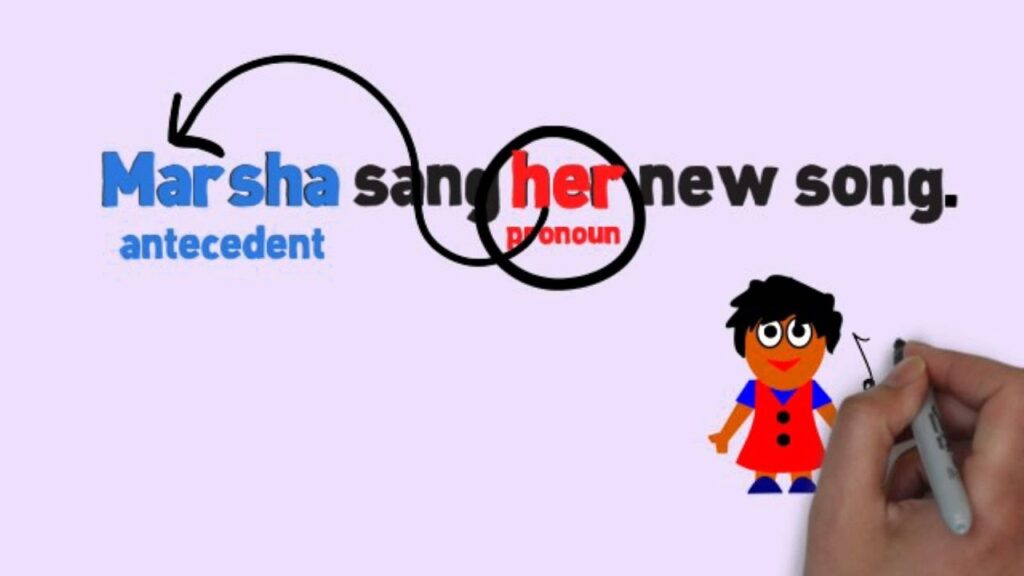
In this blog, we’re going to learn everything about antecedents.
We’ll learn how to identify antecedents in any sentence, master the rules of pronoun-antecedent agreement, and discover practical strategies for avoiding the most common mistakes.
You’ll understand the difference between explicit and implied antecedents, learn to handle complex sentences with multiple pronouns, and antecedent in grammar examples.
Let’s dive in.
Key Takeaways
- What is an antecedent in grammar? An antecedent is the noun a pronoun refers to. In “Emma lost her book,” Emma is the antecedent of her.
- Every pronoun needs a clear antecedent. Always link pronouns to a specific noun (e.g., Sarah → her). No clear noun means no clarity.
- Keep pronouns closer. Use pronouns within 1–2 sentences of their antecedents. If distance causes confusion, repeat the noun.
- Match pronouns with their antecedents in number, gender, and person. Be extra careful with collective and indefinite nouns.
- Avoid vague pronouns. Don’t use “this,” “that,” “it,” or “they” without clear context. Ask: “This what?” or “They who?”
Definition of an Antecedent
What is an antecedent in grammar? An antecedent is the noun or noun phrase that a pronoun refers to or replaces.
Every time you use a pronoun like “he,” “she,” “it,” or “they,” that pronoun needs to point back to something specific. That something is the antecedent.
Antecedents has two purposes:


Never Worry About AI Detecting Your Texts Again. Undetectable AI Can Help You:
- Make your AI assisted writing appear human-like.
- Bypass all major AI detection tools with just one click.
- Use AI safely and confidently in school and work.
- They establish clarity by making sure readers know what each pronoun refers to.
- They help prevent awkward repetition by allowing us to use pronouns instead of repeating the same nouns over and over.
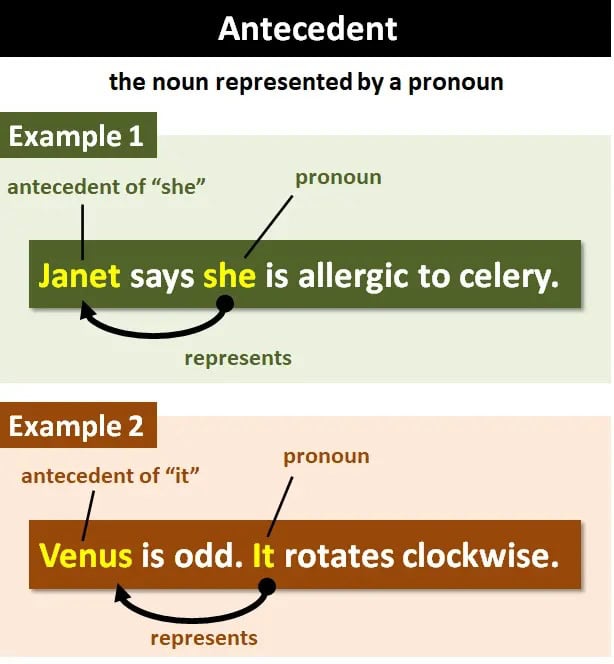
The relationship follows a simple pattern: Antecedent → Pronoun
Let’s look at two versions of the same idea:
Without clear antecedents: The manager spoke to the employee. He was upset about the policy changes. He decided to schedule another meeting.
→ Who’s upset? Who’s scheduling the meeting? We can’t tell.
Try it yourself. Paste your sentence into Ask AI and instantly see which noun your pronoun refers to.
Perfect for spotting unclear or missing antecedents in your writing.

With clear antecedents: The manager spoke to the employee. The manager was upset about the policy changes, so he decided to schedule another meeting.
→ Now we know exactly who did what. “The manager” is the antecedent for “he,” creating a clear connection that guides the reader through the sentence.
Also Read: What Are Pronouns? Definitions & Examples
Examples of Antecedents in Sentences
Now that we understand what is antecedent in grammar with examples, let’s see them in action.
- Singular and Plural Antecedents
The most basic rule is simple. Singular antecedents need singular pronouns, and plural antecedents need plural pronouns.
Singular antecedent: Sarah forgot her keys.
- Sarah (singular antecedent) → her (singular pronoun)
Plural antecedent: The students submitted their projects.
- The students (plural antecedent) → their (plural pronoun)
Here’s the pattern:
- The student lost her pencil. (one student = her)
- The students lost their pencils. (multiple students = their)
Words like “team,” “group,” “family,” and “committee” can confuse you because they refer to multiple people but are grammatically singular. The trick is context.
Acting as one unit:
→ the team celebrated its victory.
Individual member:
→ the team grabbed their gear and headed home.
- Examples with Personal Pronouns
Understanding what is an antecedent in grammar becomes clearer when you see how personal pronouns connect to their antecedents:
First person: I brought my laptop. (I = antecedent, my = pronoun)
Second person: You left your coffee on the desk. (You = antecedent, your = pronoun)
Third person – male: Marcus said he would call later. (Marcus = antecedent, he = pronoun)
Third person – female: Lisa finished her presentation early. (Lisa = antecedent, her = pronoun)
Third person – neutral: The computer crashed, so it needs repair. (The computer = antecedent, it = pronoun)
First person plural: We packed our bags for the trip. (We = antecedent, our = pronoun)
Third person plural: The neighbors invited us to their barbecue. (The neighbors = antecedent, their = pronoun)
How far apart can they be?
Good distance: Sarah walked into the meeting room. She looked nervous.
Too far: Sarah walked into the meeting room. The presentation materials were scattered across the table. Several people were already seated. She looked nervous. (Who is “she”?)
- Examples with Demonstrative or Relative Pronouns
These pronouns create more complex relationships, but the antecedent principle stays the same.
Relative Pronouns (who, which, that)
“Who” for people: The teacher who assigned homework is absent today.
- The teacher = antecedent, who = relative pronoun
“Which” for things: The book which you recommended was excellent.
- The book = antecedent, which = relative pronoun
“That” for people or things: The car that broke down belongs to my neighbor.
- The car = antecedent, that = relative pronoun
Demonstrative Pronouns (this, that, these, those)
Demonstrative pronouns can point to specific nouns or entire ideas. These examples clearly show what is a antecedent in grammar.
Pointing to specific nouns: I bought apples and oranges. These are sweet, but those are sour.
- Apples = antecedent for these, oranges = antecedent for those
Pointing to ideas: The meeting ran three hours over schedule. This frustrated everyone.
- The entire situation (meeting running over) = antecedent for this
Also Read: Full List Of Demonstrative Pronouns with Examples
For anyone wondering what is an antecedent in grammar examples in complex sentences, make sure your reader can easily identify what “this,” “that,” “these,” or “those” refers to.
When in doubt, be more specific:
“This delay frustrated everyone” instead of just “This frustrated everyone.”
Pronoun-Antecedent Agreement
Once you understand the three main types of agreement, pronoun-antecedent agreement becomes easier.
| Type of Agreement | Rule | Examples | Common Pitfalls/Fixes |
| Number Agreement | Singular antecedents need singular pronouns. Plural antecedents need plural pronouns. | – The student forgot his textbook. – The students forgot their textbooks. | Words like “everyone” or “each” are singular even though they sound plural.Example: Each person should submit his or her form. |
| Gender Agreement | Pronouns must match the gender of their antecedent. Use “he,” “she,” or “it” appropriately. | – Michael said he would drive.– Sarah said she would drive.– The car broke down, so it needs repair. | For unknown gender: Each student should bring his or her laptop.Better: Students should bring their laptops. (restructure for neutrality) |
| Person Agreement | Stay consistent with pronoun person (1st, 2nd, 3rd). Don’t shift between them. | Incorrect: When you exercise regularly, they feel better.Correct: When you exercise regularly, you feel better. | Avoid switching from “you” to “they” or “we” without a clear shift in audience. |
When you have compound antecedents, the connecting word matters.
- If they’re joined by “and,” use a plural pronoun (e.g., Tom and Jerry brought their lunch).
- But if they’re joined by “or” or “nor,” the pronoun should agree with the closest antecedent (e.g., Sarah or the boys brought their snacks → their).
Watch out for common errors. While “Everyone brought their lunch” is common in informal speech, it’s not traditionally correct.
Tip: Run your writing through our Grammar Checker to spot and fix pronoun-antecedent agreement issues, especially in longer essays or reports.
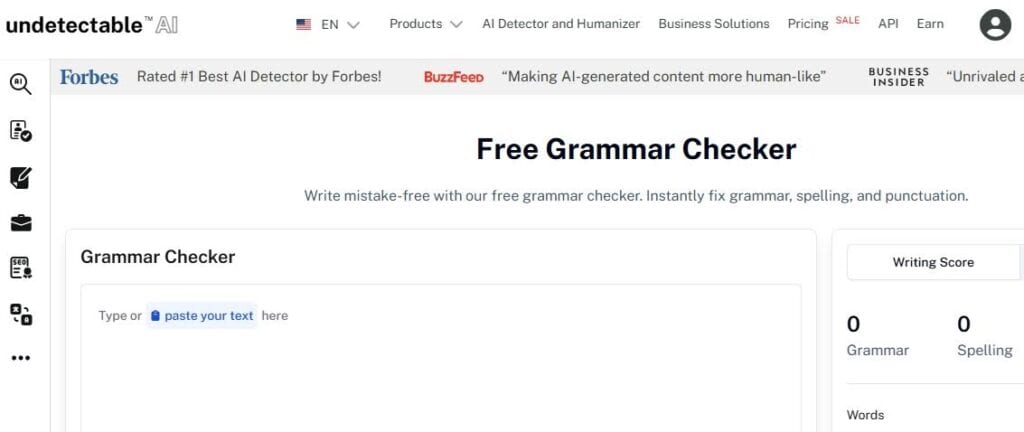
Indefinite pronouns like everyone, someone, each are always singular and take singular pronouns (e.g., Each student must submit his or her project).
- Others like some, all, none, depend on context: Some of the cake is missing (singular), Some of the students are absent (plural).
Types of Antecedents
Not all antecedents are presented the same way. Let’s understand the difference:
- Explicit vs Implied
An explicit antecedent is clearly stated in the sentence:
→ John said he was tired.
“John” is the noun, and “he” is the pronoun that refers back to it.
An implied antecedent, on the other hand, is not directly stated but understood from context:
→ After studying all night, you feel exhausted.
Here, “you” refers to a general person, it’s implied, not named.
Implied antecedents can work well in casual or conversational writing.
- Antecedents for “who,” “which,” “that,” “it,” etc.
These pronouns introduce clauses and must connect clearly to their antecedents.
“Who” for people: The woman who called you is here.
- The woman = antecedent for who
“Which” for things and animals: The cake which you baked is amazing.
- The cake = antecedent for which
“It” is used for:
- Objects: I lost my phone. It was expensive.
- Abstract ideas: Success is hard. It requires effort.
- Placeholder “it”: It’s raining. / It’s 5 o’clock.
“That” for people or things (in restrictive clauses): The book that changed my life is on the shelf.
- The book = antecedent for that
Important distinction: Use “that” for essential information and “which” for additional information:
- The car that broke down is mine. (essential—specifies which car)
- My car, which is blue, broke down. (additional—just describes the car)

- Delayed Antecedents and Stylistic Placement
Usually, a pronoun follows its antecedent. But in delayed antecedent constructions, the pronoun appears first, and the noun comes later.
Normal Order: Because she was late, Maria missed the bus.
- Maria = antecedent, she = pronoun
Delayed Antecedent: Because she was late, Maria missed the bus.
- The antecedent (Maria) comes after the pronoun (she)
This is called cataphoric reference where the pronoun points forward instead of backward.
Common Mistakes and How to Avoid Them
The most common issues come down to vagueness, ambiguity, or broken agreement between pronouns and their antecedents.
Here’s how to spot and fix them.
- Vague Use of “this,” “that,” or “it”
When you use words like this, that, or it without a clear noun behind them, your reader is left guessing.
Vague: This is frustrating.
Clear: This long application process is frustrating.
Fix: Always ask, “This what?” or “It what?” If you can’t answer immediately, specify the noun.
- Distant Antecedents
The farther a pronoun is from its noun, the harder it is to follow. As a rule of thumb, keep pronouns within one to two sentences of their antecedents. Closer is better.
Distant: The policy was introduced in early May. It… (after three more sentences) was updated again.
Closer: The policy introduced in early May was later updated in June.
Fix: Bring the pronoun and its noun closer together, or repeat the noun if needed.
Struggling with vague or distant pronouns?
Use an AI Essay Rewriter to automatically improve clarity and pronoun flow. It is perfect for essays, reports, and long-form content.
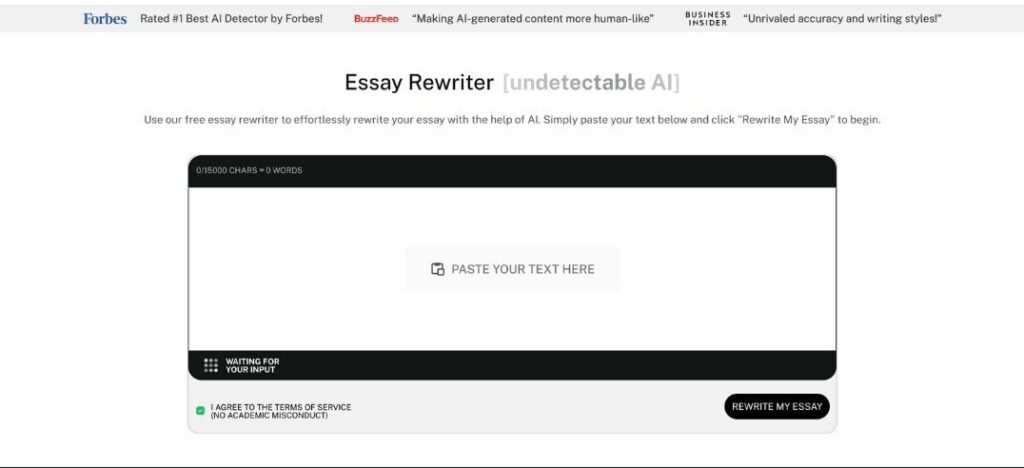
- Ambiguous Antecedents
When a sentence contains two or more possible nouns for a pronoun to refer to, meaning breaks down.
Ambiguous: John told Mike he was wrong.
Who is “he”? John or Mike?
Clear: John told Mike that Mike was wrong.
—or— John admitted he was wrong when talking to Mike.
Fix: Rephrase to make the subject unmistakable.
- Missing Antecedents
Sometimes a pronoun is used with no clear noun at all.
Missing: They say it’s going to rain.
Who is “they”? What is “it”?
Fix: Identify or remove vague references.
Correct: The weather forecast says it’s going to rain.
- Number Disagreement
A common slip is using a singular pronoun for a plural noun or vice versa, especially with collective nouns or indefinite pronouns.
Incorrect: The team forgot their uniforms.
Correct: The team forgot its uniforms. (if treated as one unit)
—or— The players forgot their uniforms. (if referring to individuals)
Fix: Check if the noun is singular, plural, or collective, and match the pronoun accordingly.
Antecedents in Complex Sentences
| Concept | Explanation | Example |
| Multiple Clauses with Multiple Antecedents | Multiple nouns in different clauses can confuse readers. | The professor said the student needed to rewrite the essay. |
| Nested Relative Clauses | Stacked clauses (e.g., “who,” “that”) make clarity difficult. | The book that belongs to the student who won the award is missing. |
| Participial Phrases & Dangling Modifiers | Introductory modifiers must match the subject directly. | Walking into the room, she was struck by the silence. |
Use an AI Humanizer to rephrase over-complicated or robotic pronoun/antecedent constructions.
It’s ideal for essays, reports, or formal content that needs a natural tone.
Want real-time grammar help?
Try AI Chat for instant feedback and hands-on practice with complex antecedents. You’ll catch mistakes as you write.
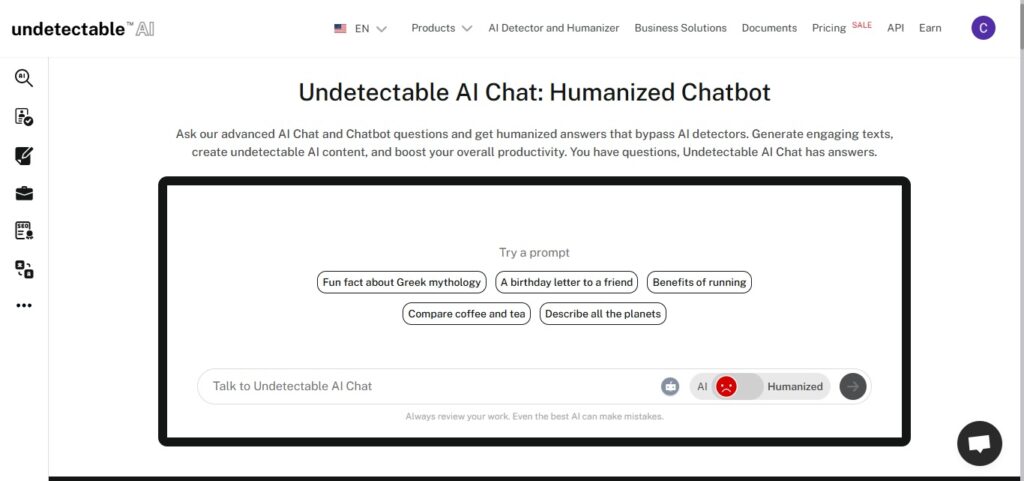
Give your words a makeover—our AI Detector and Humanizer are just below!
FAQs About Antecedents
Can an Antecedent Come After the Pronoun?
Yes. This is called cataphoric reference. Example: “Although she was tired, Sarah kept working.”
It works when the meaning is clear. Otherwise, it can cause confusion.
Are There Antecedents for “this” or “that”?
Yes. “This/That” can refer to a specific noun (“this book”) or a broader idea (“this is unfair”).
Avoid vague usage by clearly linking to a previous noun or concept.
Is a Name Always Required as an Antecedent?
No. Noun phrases (e.g., “the tall woman in red”) or generic nouns (e.g., “a student”) work as antecedents.
Commands often use implied antecedents like “you.”
What’s the Difference Between Antecedent and Subject?
The antecedent is what a pronoun refers to; the subject is who or what performs the action.
They can be the same, but not always. Example: “The teacher gave the students homework. They completed it.” (Students = antecedent, subject of second sentence.
Final Thoughts
What is an antecedent in grammar? By now, you know it’s the foundation that makes pronouns work effectively in your writing.
Every unclear pronoun creates a roadblock for your readers.
- Can they follow your meaning without hesitation?
- Do they know exactly who “he,” “she,” or “they” refers to in each sentence?
These questions matter because clarity separates good writing from confusing one.
The rules aren’t complicated.
Match pronouns to their antecedents in number, gender, and person.
Keep them close together, ideally within one to two sentences.
The next step would be to start noticing pronoun-antecedent pairs in everything you read.
Remember the simple pattern: Antecedent → Pronoun.
Master this relationship, and you’ll never leave your readers wondering who did what, when, or why.
With Undetectable AI’s AI Grammar Checker, AI Essay Rewriter, AI Chat, and AI Humanizer, you can easily refine pronoun-antecedent agreement and make your writing clearer.
Your pronouns should guide readers smoothly through your ideas, not create confusion along the way.
Take your writing to the next level—try Undetectable AI now.
